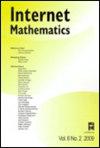LiveRank: How to Refresh Old Datasets
Q3 Mathematics
引用次数: 0
Abstract
ABSTRACT This article considers the problem of refreshing a dataset. More precisely, given a collection of nodes gathered at some time (webpages, users from an online social network) along with some structure (hyperlinks, social relationships), we want to identify a significant fraction of the nodes that still exist at present time. The liveness of an old node can be tested through an online query at present time. We call LiveRank a ranking of the old pages so that active nodes are more likely to appear first. The quality of a LiveRank is measured by the number of queries necessary to identify a given fraction of the active nodes when using the LiveRank order. We study different scenarios from a static setting where the LiveRank is computed before any query is made, to dynamic settings where the LiveRank can be updated as queries are processed. Our results show that building on the PageRank can lead to efficient LiveRanks, for web graphs as well as for online social networks.LiveRank:如何刷新旧数据集
本文研究了数据集的刷新问题。更准确地说,给定在某个时间收集的节点集合(网页、来自在线社交网络的用户)以及一些结构(超链接、社会关系),我们想要识别当前仍然存在的节点的重要部分。当前可以通过在线查询来测试旧节点的活跃度。我们称LiveRank为旧页面的排名,以便活动节点更有可能首先出现。LiveRank的质量是通过在使用LiveRank顺序时识别给定活动节点部分所需的查询数量来衡量的。我们研究了不同的场景,从静态设置(在进行任何查询之前计算LiveRank)到动态设置(在处理查询时可以更新LiveRank)。我们的研究结果表明,建立在PageRank上可以为网络图表和在线社交网络带来高效的liverank。
本文章由计算机程序翻译,如有差异,请以英文原文为准。
求助全文
约1分钟内获得全文
求助全文

 求助内容:
求助内容: 应助结果提醒方式:
应助结果提醒方式:


